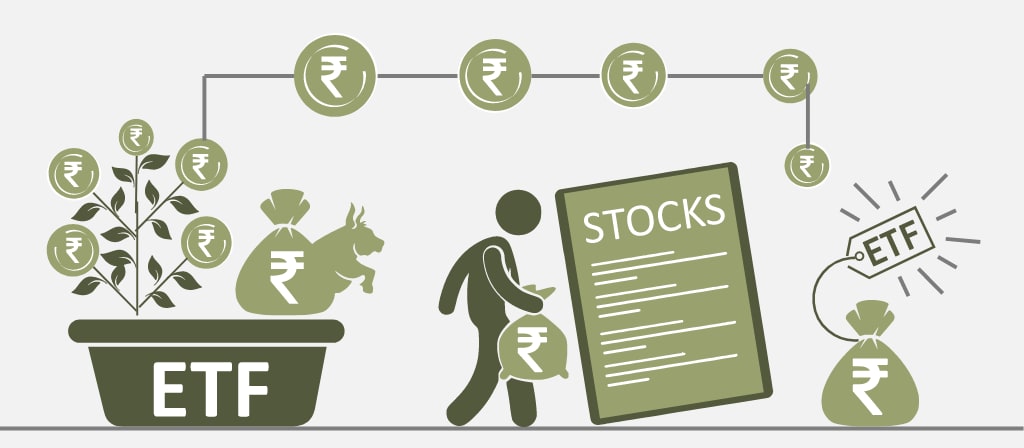Understanding Exchange-Traded Funds (ETFs): A Beginner's Guide
Exchange-Traded Funds

Introduction
Exchange-Traded Funds (ETFs) have gained immense popularity among investors in recent years. These investment vehicles offer a convenient and cost-effective way to gain exposure to various asset classes, including stocks, bonds, commodities, and more. For beginners, understanding the fundamentals of ETFs is crucial to make informed investment decisions. In this article, we will provide a comprehensive beginner's guide to ETFs, covering their definition, structure, benefits, and considerations for potential investors.
1. What are ETFs?
a. Definition: An Exchange-Traded Fund (ETF) is an investment fund that trades on stock exchanges, similar to individual stocks. ETFs aim to track the performance of a specific index, sector, commodity, or asset class.
b. Structure: ETFs are structured as open-end investment companies or unit investment trusts. They issue shares that represent ownership in the underlying portfolio of assets.
2. Benefits of ETFs
a. Diversification: ETFs offer instant diversification by providing exposure to a basket of securities within a specific market or asset class. Investors can access a wide range of investments with a single ETF, reducing individual stock or sector risk.
b. Cost-Effectiveness: ETFs are known for their relatively low expense ratios compared to mutual funds. They are passively managed and designed to replicate the performance of an underlying index, resulting in lower management fees.
c. Liquidity and Transparency: ETFs trade on stock exchanges throughout the trading day, providing investors with liquidity and the ability to buy or sell shares at market prices. The transparency of ETF holdings allows investors to know the underlying assets and their respective weights.
d. Flexibility: ETFs offer flexibility in terms of investment strategies. Investors can buy or sell ETF shares throughout the trading day at market prices, utilize advanced order types, and implement trading strategies like limit orders or stop-loss orders.
e. Dividends and Reinvestment: Many ETFs pay dividends based on the income generated by the underlying assets. Investors can choose to receive these dividends as cash or reinvest them automatically through dividend reinvestment plans (DRIPs).
3. Types of ETFs
a. Equity ETFs: These ETFs invest in a basket of stocks to replicate the performance of an equity index, such as the S&P 500 or Nasdaq. They offer broad market exposure or can focus on specific sectors, regions, or market capitalization.
b. Bond ETFs: Bond ETFs provide exposure to various types of fixed-income securities, including government bonds, corporate bonds, municipal bonds, or specific bond market segments. They can offer diversification within the bond market and provide income through coupon payments.
c. Commodity ETFs: Commodity ETFs track the price movements of commodities like gold, silver, oil, or agricultural products. They provide a convenient way for investors to gain exposure to commodity markets without the need for physical commodity ownership.
d. Sector ETFs: Sector ETFs focus on specific sectors of the economy, such as technology, healthcare, energy, or financial services. They allow investors to target specific industries or market segments.
e. International ETFs: International ETFs provide exposure to foreign markets or specific countries. They allow investors to diversify their portfolios beyond domestic markets and capitalize on global investment opportunities.
4. Considerations for Potential Investors
a. Investment Objectives: Determine your investment goals, risk tolerance, and time horizon before investing in ETFs. Understand which asset classes or sectors align with your objectives and select ETFs that suit your investment strategy.
b. Expense Ratios: Compare the expense ratios of different ETFs to ensure you are selecting cost-effective options. Lower expense ratios can result in higher net returns over the long term.
c. Liquidity and Trading Volume: Consider the liquidity and average trading volume of the ETFs you are interested in. Higher liquidity ensures ease of buying and selling shares without significant price impact.
d. Tracking Error: Assess the historical tracking error of an ETF. Tracking error measures the deviation of an ETF's performance from its underlying index. Lower tracking error indicates better replication of the index's returns.
e. Tax Efficiency: Understand the potential tax implications of investing in ETFs, such as capital gains distributions. ETFs structured as "in-kind" creations and redemptions may offer tax advantages compared to mutual funds.
f. Fund Provider Reputation: Evaluate the reputation and track record of the ETF provider. Choose reputable providers with a history of offering high-quality ETFs and strong investor support.
5. Building a Portfolio with ETFs
a. Asset Allocation: Determine your desired asset allocation based on your investment objectives and risk tolerance. Allocate your investments across different asset classes, such as stocks, bonds, and commodities, using ETFs that provide exposure to each asset class.
b. Rebalancing: Regularly review and rebalance your portfolio to maintain your desired asset allocation. Rebalancing involves adjusting your investments to bring them back in line with your target allocation.
c. Dollar-Cost Averaging: Consider using dollar-cost averaging to invest regularly in ETFs over time.This strategy involves investing a fixed amount at regular intervals, regardless of market conditions, to potentially benefit from cost averaging and mitigate the impact of short-term market volatility.
d. Portfolio Monitoring: Stay informed about the performance of your ETF holdings and monitor the underlying assets and market conditions. Periodically review your investment strategy and make adjustments as needed.
Conclusion
Exchange-Traded Funds (ETFs) provide investors with a convenient and cost-effective way to gain exposure to a wide range of asset classes and market segments. With benefits such as diversification, cost-effectiveness, liquidity, and flexibility, ETFs have become increasingly popular among both novice and experienced investors. Understanding the basics of ETFs, considering factors such as expense ratios, liquidity, and tracking error, and aligning your investment strategy with your objectives are essential for making informed investment decisions. By incorporating ETFs into a well-diversified portfolio and regularly reviewing your investment strategy, you can harness the potential of these investment vehicles to pursue your financial goals. Remember to conduct thorough research, consult with financial professionals if needed, and stay focused on your long-term investment objectives.
About the Creator
Enjoyed the story? Support the Creator.
Subscribe for free to receive all their stories in your feed. You could also pledge your support or give them a one-off tip, letting them know you appreciate their work.





Comments
There are no comments for this story
Be the first to respond and start the conversation.